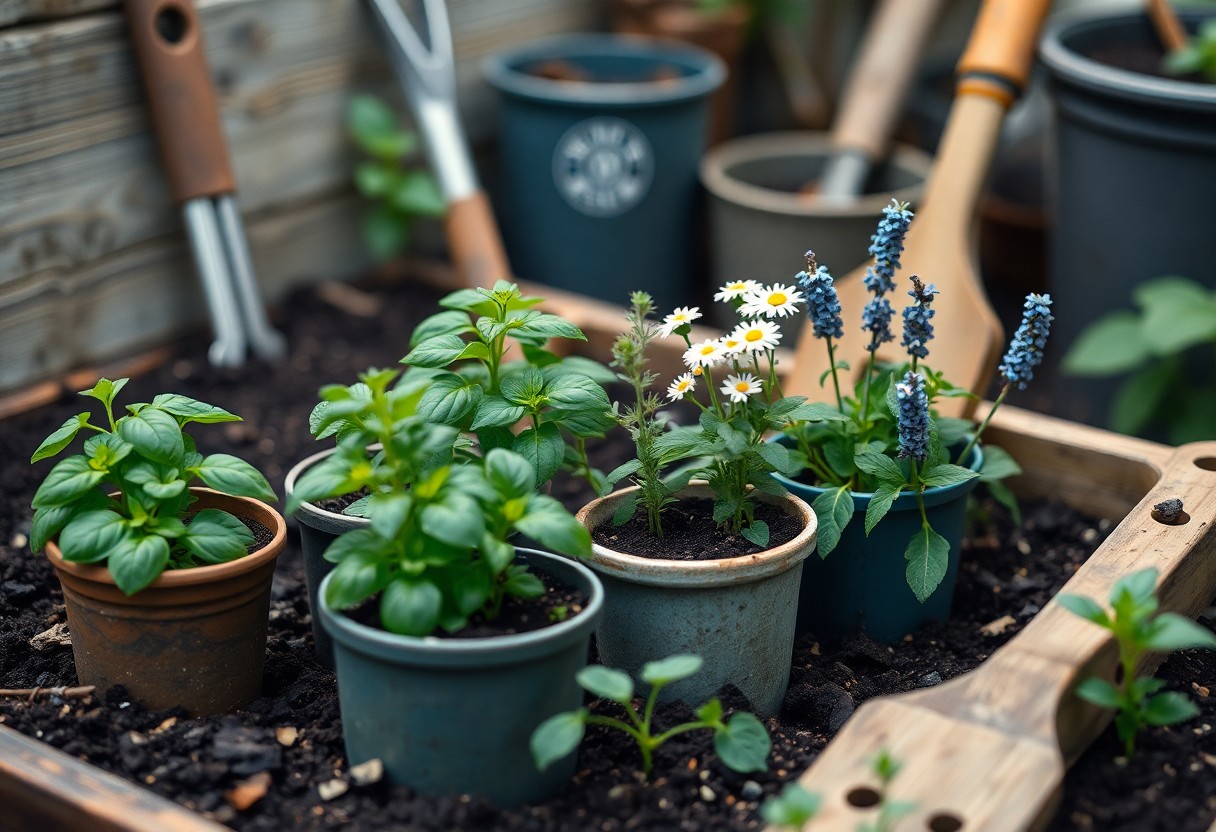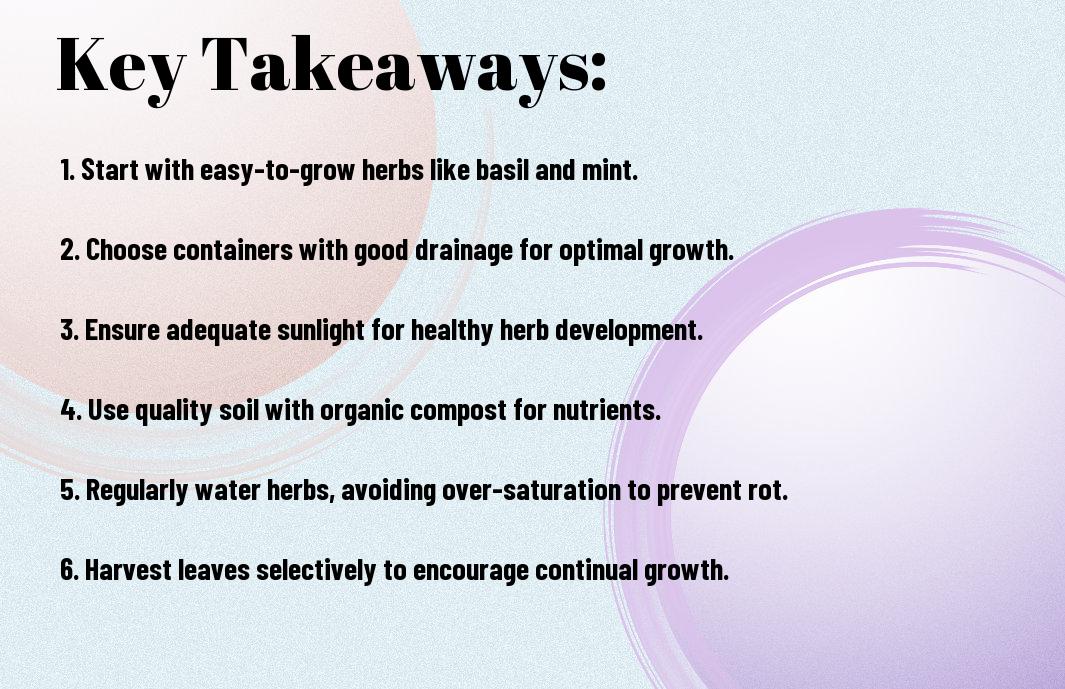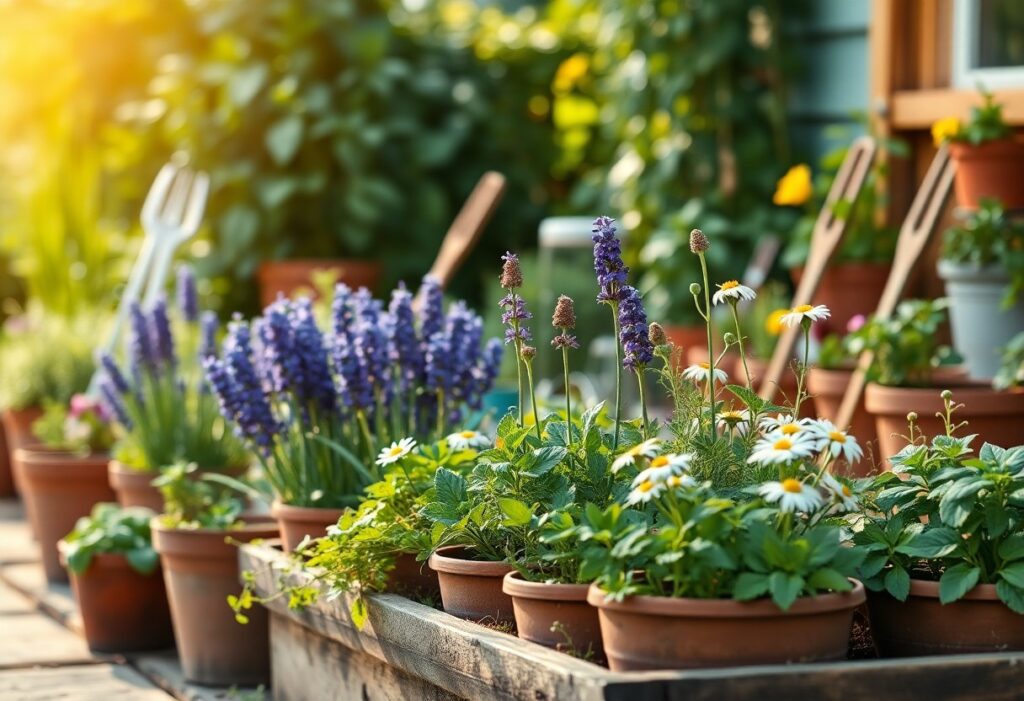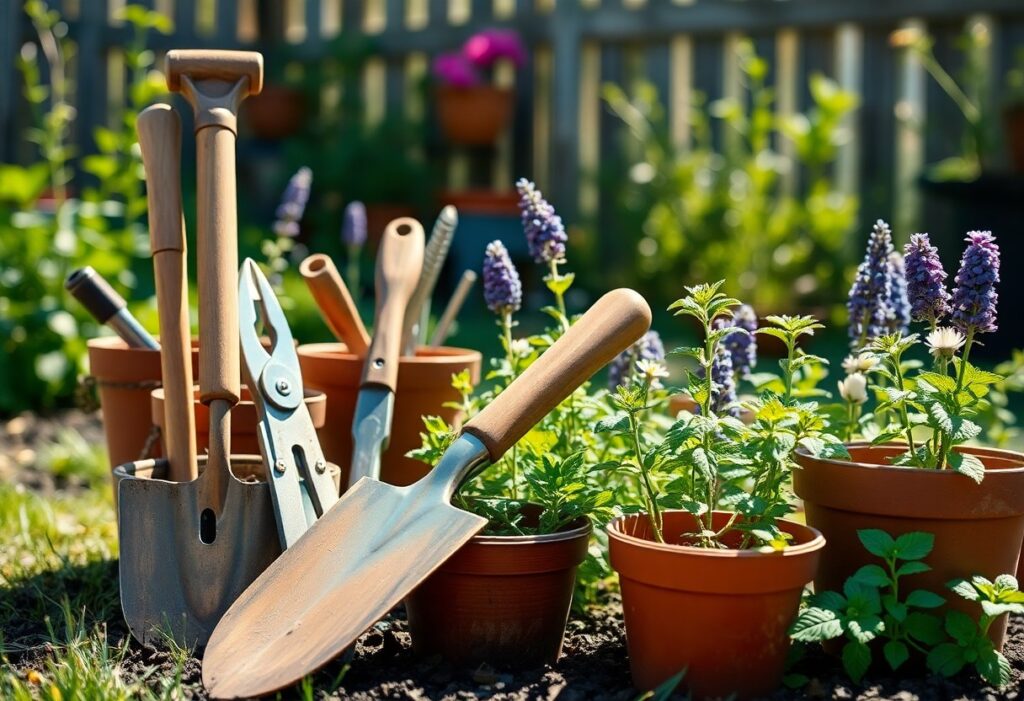As a beginner in the world of herb gardening, it can be exciting to explore the benefits of medicinal herbs that you can easily cultivate at home. In this guide, I will share with you the finest herbs that not only thrive in small spaces but also provide numerous health advantages. You’ll discover how to grow these plants effectively, ensuring that you can utilize fresh, natural remedies in your daily life. From soothing chamomile to healing peppermint, I’m here to help you commence on this rewarding journey.

Key Takeaways:
- Accessibility: Many medicinal herbs are easy to grow at home, making them perfect for beginners.
- Variety: Common herbs like basil, mint, and rosemary offer a range of health benefits and culinary uses.
- Space Requirements: Most medicinal herbs can thrive in small spaces, whether in pots or garden beds, requiring minimal maintenance.
- Growth Conditions: Understanding basic requirements such as sunlight, soil, and watering can lead to successful herb cultivation.
- Health Benefits: Growing your own herbs provides convenient access to natural remedies for common ailments like digestion, stress, and inflammation.

Benefits of Growing Medicinal Herbs
While cultivating medicinal herbs at home may seem like a small venture, the benefits extend far beyond the mere act of gardening. Growing these herbs gives you direct access to nature’s pharmacy, allowing you to create remedies right in your kitchen. You can enjoy the satisfaction of nurturing plants that contribute positively to your health and well-being. Moreover, when you grow your own medicinal herbs, you gain control over what you consume, leading to a more sustainable and personalized approach to health care.
Health Advantages
Across various cultures and practices, medicinal herbs have been utilized for centuries to support health and well-being. By growing your own herbs, you can create potent tinctures, teas, and salves, harnessing the healing properties of plants like chamomile, mint, and lavender. Not only can these natural remedies alleviate minor ailments such as headaches or digestive issues, but they can also contribute to your overall wellness routine. Utilizing herbs you’ve grown yourself allows me to have peace of mind regarding quality and purity, ensuring that what I consume is free from harmful pesticides and additives.
Environmental Impact
After recognizing the health advantages of growing medicinal herbs, it’s imperative to consider their impact on the environment. Cultivating your own herbs supports biodiversity and reduces the need for commercially produced alternatives that may involve harmful agricultural practices. By choosing to grow at home, you are minimizing your carbon footprint, as there is no need for extensive transportation and packaging that accompanies store-bought options. In essence, you are not only improving your health but also contributing to a healthier planet.
Benefits also stem from the fact that growing medicinal herbs can enhance soil health by promoting a variety of beneficial microorganisms. Each plant contributes to a more robust ecosystem, allowing pollinators and beneficial insects to thrive. Plus, as you create your little green sanctuary, you are playing a part in combatting urban heat and contributing to cleaner air. Thus, this dual approach of nurturing your health while protecting the environment creates a holistic cycle of positive impacts on both personal and ecological levels.
Essential Medicinal Herbs to Start With
If you’re new to growing medicinal herbs at home, you’ll want to begin with a few that are not only easy to cultivate but also versatile in their uses. Among the plethora of options, I highly recommend focusing on basil and peppermint. These herbs have been used for centuries not only for their culinary delights but also for their numerous health benefits, making them perfect for beginners looking to investigate home gardening. Their appealing aroma and bright flavor will encourage you to incorporate them into your daily life, making the effort of growth worthwhile.
Basil
Before you start growing basil, you should know that it thrives in warm weather and well-drained soil. I find that sowing seeds indoors and then transplanting them after the last frost is the most effective method. Basil can provide a refreshing flavor to dishes while also serving as a natural remedy for digestive issues, stress relief, and even inflammation. By nurturing this herb in your home garden, you’ll not only enhance your meals but also tap into its medicinal properties.
Peppermint
Beside basil, peppermint is another fantastic herb to grow. It is remarkably easy to care for, needing little more than ample sunshine and moisture. You’ll be delighted to know that peppermint is renowned for its ability to soothe digestive problems, relieve headaches, and provide a calming effect on the mind. I often find myself making peppermint tea, especially after a heavy meal; it’s not only refreshing but also provides effective relief!
Indeed, peppermint offers not only delightful flavors but also various therapeutic uses. Its aroma can help alleviate stress and enhance mental clarity, while its leaves serve as a potent remedy for digestive troubles. Growing peppermint will allow you to harness its multiple benefits right in your home, providing easy access to its soothing qualities whenever you need them. I’ve enjoyed planting peppermint in containers, as it can spread rapidly in the garden, so controlling its growth is important. With its fragrant leaves, peppermint not only beautifies your space but also contributes significantly to your health and wellness journey.
Growing Conditions and Care
Once again, when it comes to growing medicinal herbs at home, providing the right growing conditions and care will make a significant difference in their health and potency. I recommend starting with the basics: understanding the imperative requirements for your herbs will not only promote growth but will also enhance the medicinal properties that you’re aiming to benefit from. This includes factors such as soil composition, sunlight exposure, and watering techniques. Each herb has its unique preferences, so being aware of these can help you cultivate a thriving herbal garden.
Soil Requirements
Along with sunlight and water, the right soil mix is fundamental to the growth of your medicinal herbs. Most herbs thrive in well-draining soil enriched with organic matter, such as compost. I suggest aiming for a pH level between 6.0 to 7.0 for a broad range of herbs. Some herbs, like oregano and thyme, prefer sandy or loamy soil, while others, such as basil and cilantro, flourish in richer, more nutrient-dense environments. Testing your soil before planting can help you make necessary amendments to create an optimal growing space.
Watering and Sunlight Needs
To ensure healthy growth, you’ll need to pay attention to the watering and sunlight needs of your herbs. Most herbs prefer a balance of moisture and well-drained conditions; overwatering can lead to rot, while underwatering can hinder their growth. Generally, I find that watering deeply once or twice a week is sufficient, depending on the weather and the specific needs of your plants. Pertaining to sunlight, most herbs require between 6 to 8 hours of direct sunlight each day. This will help in developing robust flavors and enhanced medicinal qualities.
Further, it’s imperative to observe your herb plants regularly. Factors such as the changing seasons may affect their growth; for instance, you may need to adjust your watering frequency during hotter months. Additionally, if your herbs seem leggy or pale, it might indicate that they’re not receiving enough sunlight. On the other hand, if the leaves turn yellow or mushy, it’s a sign that you might be overwatering them. With careful attention to these details, you can cultivate a thriving medicinal herb garden right in your home.

Common Pests and Diseases
To effectively grow medicinal herbs at home, it’s important to recognize the common pests and diseases that can threaten your plants. I have encountered issues with aphids, spider mites, and whiteflies, which can all cause significant damage to your herbs if left unchecked. These pests typically appear on the undersides of leaves, often resulting in curled or discolored foliage. Additionally, fungal infections like powdery mildew can thrive in humid conditions, leading to a dusty appearance on leaves and potentially stunting your plants’ growth. Being vigilant about identifying these issues early can save you a lot of trouble down the line.
Identification
Against these threats, you should closely examine your herbs on a regular basis. Look for webbing, which is a telltale sign of spider mites, or small, sticky residues that might indicate an aphid infestation. Checking for wilting or yellowing leaves can provide clues to underlying problems, whether they stem from pests or diseases. I often keep a magnifying glass on hand for a closer look and take note of any changes in leaf color or texture, as early detection is your best strategy for managing these issues.
Organic Solutions
For those wanting to keep their gardens free from harmful chemicals, I have found several organic solutions that effectively tackle pests and diseases. Neem oil, for example, is a fantastic natural insecticide that disrupts the life cycles of many pests, reducing their populations without harming beneficial insects. Insects like ladybugs can be introduced to help with aphid control, and a simple mix of water and dish soap can also deter unwanted invaders. Regularly watering your plants early in the day can help maintain soil moisture levels while allowing leaves to dry off before evening, reducing the risk of fungal infections.
Another approach is to focus on maintaining your herbs’ health to make them less susceptible to pests and diseases. By ensuring they receive the appropriate amount of sunlight, water, and nutrients, I’ve noticed that my plants are more resilient. Additionally, I rotate crops and practice good garden hygiene, such as removing any dead or diseased foliage, which can harbor pests. These consistent practices not only foster a healthier garden environment but also enhance the efficacy of the organic solutions you employ. Strong, thriving plants are often your best defense against pests and diseases!
Harvesting and Storage Techniques
All herbs have their unique harvesting and storage requirements, which are vital to ensuring their medicinal properties remain intact. When you grow your own herbs, you are not only rewarded with fresh, organic produce, but also the satisfaction of knowing you have taken care of them from seed to harvest. Expanding your knowledge about proper harvesting techniques will empower you to maximize the benefits of your medicinal herbs. The timing and method you use to harvest your herbs can greatly influence their aroma, flavor, and medicinal efficacy.
Proper Timing
Beside learning when to sow your herbs, understanding the right time to harvest them is equally significant. Most herbs are best harvested in the morning after the dew has dried, but before the sun has fully risen, as this is when their vital oils are at their peak. For example, I typically pick my basil and mint leaves just before flowering to capture their full flavor profile, ensuring that I get the most out of my efforts. Also, keep in mind the specific growth stages of each herb, as some—like chamomile—are best harvested just as the flowers are blooming.
Best Practices for Preservation
By implementing good preservation techniques, I can ensure that my harvested herbs maintain their medicinal properties for longer periods. One of the most effective methods is drying, which can be done by hanging bunches of herbs in a well-ventilated area out of direct sunlight. Additionally, utilizing airtight jars for storage will help prevent moisture and air exposure, preserving the potency of your herbs. Freezing has also become a favorite among many herbal enthusiasts, as it can extend the shelf life of herbs without compromising their flavor.
Due to the nature of herbs losing their potency over time, I make it a point to label my preserved herbs with the date of harvest and use them within a year for the best results. It’s vital to monitor the condition of your stored herbs and discard any that show signs of mold or spoilage. Using these preservation techniques not only secures the quality of your herbs but also gives you confidence knowing that you can access their incredible health benefits when you need them most.
Using Medicinal Herbs in Everyday Life
Your home can become a personal apothecary when you incorporate medicinal herbs into your daily routine. These versatile plants can be used in a variety of ways, enhancing both the flavor of our meals and promoting well-being. Medicinal herbs not only provide flavor and nutrition but also connect you to the age-old tradition of herbal medicine. By learning how to use these herbs effectively, you can unlock a treasure trove of health benefits right from your kitchen garden.
Cooking and Flavoring
Using fresh herbs in your cooking can elevate your dishes while imparting their medicinal properties. Herbs like basil, oregano, and rosemary not only add a burst of flavor but also possess anti-inflammatory and antioxidant qualities. By infusing your meals with these herbs, you can create a delightful culinary experience while supporting your body’s natural defenses. Experimenting with different combinations will not only enhance your cooking skills but also help you discover new flavors and aromas that align with your personal tastes.
Home Remedies
Any herb garden you cultivate can also provide the tools for effective home remedies. From chamomile tea for relaxation to ginger for digestive issues, I find that having these potent herbs readily available can drastically improve my health regimen. You can make extracts, tinctures, or simple infusions that address common ailments, helping you to avoid over-the-counter medications that may come with unwanted side effects.
Flavoring your meals with medicinal herbs is just one part of the equation. In terms of home remedies, understanding the specific health benefits associated with each herb can empower you to tackle minor health issues naturally. For instance, using peppermint can soothe headaches while lavender promotes relaxation and stress relief. Integrating these remedies into your life not only helps in managing health concerns but also enhances the connection you have with your own wellness journey.
To wrap up
Following this guide, you’ll be equipped with the knowledge to begin on your journey of growing medicinal herbs at home. I have highlighted some of the best herbs for beginners, such as basil, mint, and chamomile, which offer unique health benefits and are relatively easy to cultivate. You don’t need an extensive garden; even a small pot on your windowsill can provide a personal supply of fresh herbs for your kitchen and natural remedies.
As you start this rewarding endeavor, I encourage you to experiment with different herbs and find what works best for your environment. You’ll likely discover that growing medicinal herbs not only enhances your culinary experiences but also connects you to the powerful healing traditions of herbal medicine. Happy gardening, and may your herbal journey be fruitful and fulfilling!
FAQ
Q: What are the best medicinal herbs for beginners to grow at home?
A: Some of the top medicinal herbs that are great for beginners include basil, mint, chamomile, lavender, and lemon balm. These herbs are relatively easy to cultivate, require minimal maintenance, and can thrive in various growing conditions. Each herb also offers unique medicinal properties, making them useful additions to your home garden.
Q: How do I start growing medicinal herbs indoors?
A: To start growing medicinal herbs indoors, select a few easy-to-grow options like basil, parsley, or mint. Choose small pots or containers with good drainage and use a quality potting mix. Place the pots in a location that receives plenty of sunlight, ideally 6-8 hours a day. Water the herbs regularly, ensuring the soil remains moist but not soggy. Consider using grow lights if sufficient natural sunlight is unavailable.
Q: What are the health benefits of growing medicinal herbs at home?
A: Growing medicinal herbs at home provides numerous health benefits, including improved digestion, enhanced immune support, and stress relief. Herbs like chamomile can aid relaxation and sleep, while mint can alleviate digestive discomfort. Having fresh herbs readily available encourages people to incorporate these natural remedies into their diets, promoting overall wellness.
Q: How can I use the medicinal herbs I grow at home?
A: There are various ways to utilize medicinal herbs grown at home. You can make herbal teas by steeping fresh leaves, create oils or tinctures for topical use, or incorporate them into culinary dishes for additional flavor and health benefits. Experiment with different methods, such as drying herbs for long-term storage or infusing them in vinegar or honey for specialized remedies.
Q: Are there any pests or diseases I should watch for when growing medicinal herbs?
A: Yes, like any other plants, medicinal herbs can be susceptible to pests and diseases. Common issues include aphids, spider mites, and powdery mildew. Keep an eye on your plants for signs of distress such as yellowing leaves or spots. To manage pests, you can use organic solutions like neem oil or insecticidal soap. Ensuring good air circulation and not overwatering can help prevent diseases.


